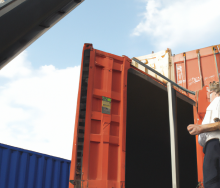The global supply chain process involves the movement of goods and products from manufacturers (factories) to distributors and ultimately to customers in another country. The key players in this process include:
-
Manufacturers: They are responsible for producing the goods and products that are to be shipped to another country.
-
Exporters: They handle the export process, including obtaining necessary documentation, arranging for shipping and customs clearance, and coordinating with freight forwarders.
-
Freight forwarders: They are responsible for the logistics of moving the goods from the manufacturer to the port of export.
-
Customs and regulatory agencies: They ensure that all imports and exports comply with laws and regulations, including tariffs, taxes, and inspections.
-
Importers: They handle the import process, including arranging for customs clearance and delivery of the goods to the distributor or customer.
-
Distributors: They act as intermediaries between importers and retailers, and are responsible for warehousing, inventory management, and distribution to retailers or end customers.
-
Retailers: They are the final link in the supply chain and sell the goods to customers.
All of these players work together to ensure that the goods are produced, exported, imported, and distributed efficiently and in compliance with all laws and regulations.
The global supply chain process also includes cargo carriers, which are responsible for physically transporting the goods from one location to another. These can include various modes of transportation such as ships, trucks, trains and airplanes. The cargo carrier plays a crucial role in the supply chain as they are responsible for ensuring that the goods are delivered to the right place at the right time. They also handle the loading and unloading of the cargo and providing necessary documentation to facilitate customs clearance.
There are different types of cargo carriers, such as:
- Container ships: They are used to transport large quantities of cargo in large metal containers.
- Airfreighters: They are used to transport cargo by air, typically for time-sensitive or high-value goods.
- Trucks: They are used to transport cargo over land, typically for shorter distances or for goods that require frequent delivery.
- Trains: They are used to transport cargo over land, typically for longer distances and bulkier goods.
Cargo carriers are also subject to various regulations and laws, and must comply with international maritime and aviation standards. They also need to ensure that the cargo is properly packaged and secured for transport to avoid damages.
Cargo carriers are a major component of the supply chain process and play a crucial role in ensuring the timely and safe delivery of goods to the final destination.
Ports serve as the point of entry and exit for cargo traveling by sea. At the port, cargo is loaded and unloaded from ships, and then transported to warehouses or distribution centers for further processing.
Ports are responsible for handling large volumes of cargo and ensuring that it is properly processed for import or export. This includes tasks such as:
- Loading and unloading cargo from ships
- Inspecting cargo for compliance with laws and regulations
- Facilitating customs clearance
- Arranging for storage and transportation of cargo to its next destination
Ports also play a crucial role in the use of shipping containers in the global supply chain. Shipping containers are large metal boxes used to transport cargo by sea, rail and truck. They are standardized in size and design, which makes them easy to load and unload, stack, and transport. This standardization allows for cargo to be easily transferred from one mode of transportation to another, which makes the supply chain more efficient and cost-effective.
Containers are an essential component of the global supply chain, as they protect the cargo during transport, can be easily tracked, and are more efficient than traditional methods of cargo transport. They also reduce the risk of cargo loss, damage, and theft.
Airports are an important part of the global supply chain process, specifically for air cargo transportation. Air cargo is used to transport time-sensitive or high-value goods, such as electronics, medical equipment, and perishable items. Airports are responsible for handling large volumes of air cargo and ensuring that it is properly processed for import or export.
Similar to seaports, airports have a designated area for cargo handling, known as a cargo terminal or freight terminal. This is where cargo is received, inspected, and prepared for transport. Airports also play a crucial role in facilitating the customs clearance process for air cargo.
Airports also have specialized infrastructure to handle air freight, such as cargo handling equipment, temperature-controlled storage, and dedicated air cargo aircraft. The cargo handling equipment includes conveyor belts, loading bridges, and specialized vehicles to move cargo around the airport.
Airports also have cargo agents who work with airlines and freight forwarders to ensure the cargo is properly packaged, labeled, and loaded onto the aircraft. They also handle the necessary documentation and customs clearance for the cargo.
Airports play a critical role in the global supply chain by allowing for the efficient and timely transportation of goods via air, which is especially important for time-sensitive and high-value products.
Global trade has a long history, dating back to ancient civilizations. The earliest forms of trade were simple barter exchanges between different communities. Over time, trade became more complex as civilizations developed different forms of currency and more advanced transportation methods.
One of the most significant developments in global trade was the invention of the compass and the development of seafaring technology in ancient China and the Mediterranean. This allowed for the transportation of goods over long distances by sea, which greatly expanded the reach of trade.
During the Middle Ages, the Silk Road was a key trade route that connected Asia with Europe and Africa. This trade route facilitated the exchange of goods such as silk, spices, and precious metals.
In the 15th century, with the Age of Exploration, European explorers began to discover new trade routes to Asia and the Americas. This led to the establishment of colonies and the expansion of global trade.
The industrial revolution in the 18th and 19th centuries brought about significant changes in global trade. The use of machines in production increased the efficiency and reduced the cost of manufacturing goods. This led to an increase in trade between countries as they began to specialize in producing certain goods.
In the 20th century, technological advances such as the containerization of cargo and the development of air cargo greatly increased the efficiency and speed of global trade. The growth of international trade organizations such as the World Trade Organization (WTO) and the North American Free Trade Agreement (NAFTA) have also played a role in promoting global trade.
Overall, global trade has evolved over time, from simple barter exchanges to the highly complex and interconnected global trade system we have today, driven by technology and facilitated by international trade agreements and organizations.










